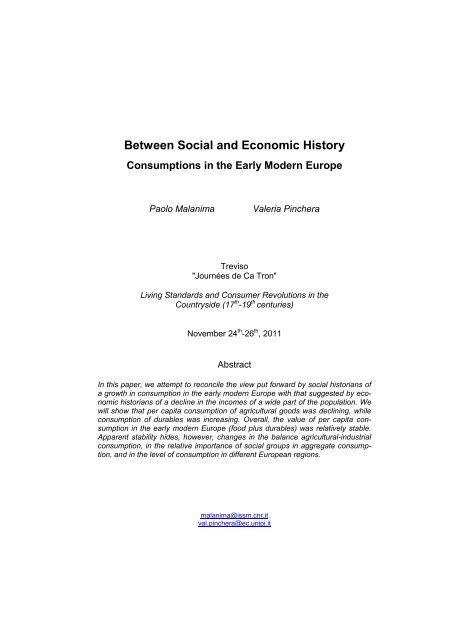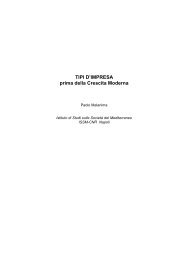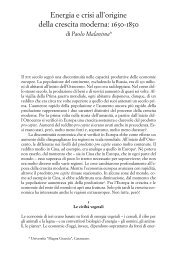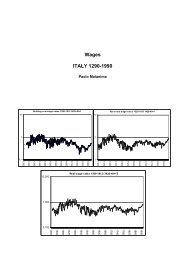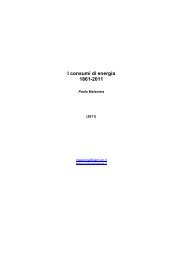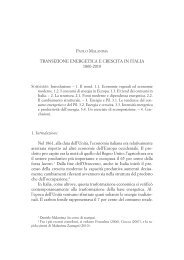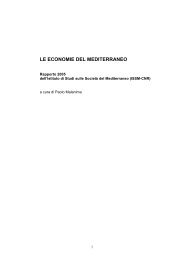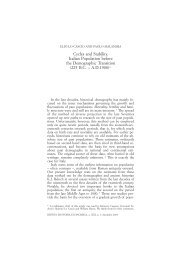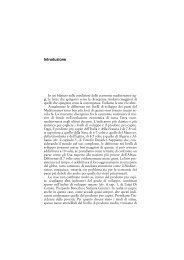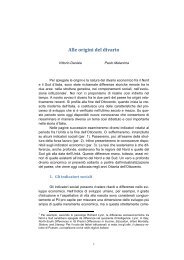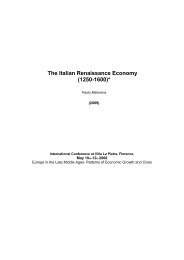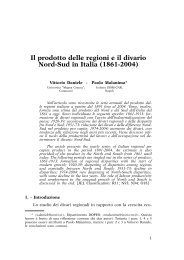Between Social and Economic History - Paolo Malanima
Between Social and Economic History - Paolo Malanima
Between Social and Economic History - Paolo Malanima
You also want an ePaper? Increase the reach of your titles
YUMPU automatically turns print PDFs into web optimized ePapers that Google loves.
<strong>Between</strong> <strong>Social</strong> <strong>and</strong> <strong>Economic</strong> <strong>History</strong><br />
Consumptions in the Early Modern Europe<br />
<strong>Paolo</strong> <strong>Malanima</strong><br />
Valeria Pinchera<br />
Treviso<br />
"Journées de Ca Tron"<br />
Living St<strong>and</strong>ards <strong>and</strong> Consumer Revolutions in the<br />
Countryside (17 th -19 th centuries)<br />
November 24 th -26 th , 2011<br />
Abstract<br />
In this paper, we attempt to reconcile the view put forward by social historians of<br />
a growth in consumption in the early modern Europe with that suggested by economic<br />
historians of a decline in the incomes of a wide part of the population. We<br />
will show that per capita consumption of agricultural goods was declining, while<br />
consumption of durables was increasing. Overall, the value of per capita consumption<br />
in the early modern Europe (food plus durables) was relatively stable.<br />
Apparent stability hides, however, changes in the balance agricultural-industrial<br />
consumption, in the relative importance of social groups in aggregate consumption,<br />
<strong>and</strong> in the level of consumption in different European regions.<br />
malanima@issm.cnr.it<br />
val.pinchera@ec.unipi.it
<strong>Between</strong> <strong>Social</strong> <strong>and</strong> <strong>Economic</strong> <strong>History</strong><br />
Consumptions in the Early Modern Europe<br />
<strong>Paolo</strong> <strong>Malanima</strong><br />
Valeria Pinchera<br />
Since the 1980s the interest for consumptions in the early Modern Europe<br />
rose, probably on the wave of rising mass consumption in our modern societies. 1 A<br />
new generation of historians began to follow the lines of research undertaken by J.<br />
Thirsk <strong>and</strong> N. Mc Kendrick, J. Brewer <strong>and</strong> J. H. Plumb <strong>and</strong> to stress the importance<br />
of dem<strong>and</strong> in the socio-economic transformation of Europe in the late 17 th <strong>and</strong> 18 th<br />
centuries. 2 Research on Engl<strong>and</strong>, France, The Netherl<strong>and</strong>s <strong>and</strong> American colonies<br />
recognized the 18 th century as an epoch of rise in the consumption of durable<br />
goods among different social groups, favoured by the development of trade techniques<br />
<strong>and</strong> distribution. Historians began to speak of a “consumer revolution”,<br />
which preceded <strong>and</strong> favoured the industrial revolution. 3 This revolution did not only<br />
concern durables, but also consumables such as sugar, tea, coffee, tobacco <strong>and</strong><br />
new kinds of textiles, all of which spread into the lower strata of society. 4 In this<br />
kind of research, a micro-historical approach prevailed. 5 Research on pre-modern<br />
rise in consumptions concerned, on the whole, a limited share of the European<br />
population, especially North-Western regions, <strong>and</strong> thus was hardly representative<br />
of the whole continent. Often, research on some Northern European regions, particularly<br />
Engl<strong>and</strong>, has been generalized; so doing a tiny share of Europe has become<br />
representative of the entire continent. It is often forgotten that, in pre-modern<br />
economies, Engl<strong>and</strong> is not the norm, but the exception.<br />
<strong>Economic</strong> historians, however, began to stress the contrast between the<br />
theory of a consumer revolution <strong>and</strong> the trend of prices <strong>and</strong> incomes. 6 Both past<br />
<strong>and</strong> recent research in this field have in fact highlighted a decline rather than an in-<br />
1 See Braudel, Civilisation materielle, économie et capitalisme.<br />
2 Thirsk, <strong>Economic</strong> policy <strong>and</strong> Projects <strong>and</strong> McKendrick, Brewer, Plumb, The Birth of a Consumer society.<br />
3 Among others: Brewer, Porter, Consumption <strong>and</strong> World of Goods; Perrot, Le luxe: une richesse entre<br />
faste et confort; Roche, Histoire des choses banales; Schama, The Embarrassment of Riches; Shammas,<br />
The Pre-industrial Consumer <strong>and</strong> Weatherill, Consumer Behaviour <strong>and</strong> Material Culture in Britain.<br />
4 For a general overview, see Clemente, Storiografie di confine?, about the different branches of research,<br />
see the recent studies by Capuzzo, Culture del consumo; Higman, The Sugar Revolution; De<br />
Vries, The Industrious Revolution; Lemire, The Force of Fashion in Politics <strong>and</strong> Society; Berg, Eger,<br />
Luxury in the Eighteenth Century <strong>and</strong> North, Material Delight <strong>and</strong> the Joy of Living.<br />
5 A macroeconomic view has, however, also been exploited. In the recent research of Hersch-Voth,<br />
Sweet Diversity, <strong>and</strong> Rönnbäck, An Early Modern Consumer Revolution in the Baltic it is retained that<br />
sugar, tea <strong>and</strong> coffee determined an improvement of the European diet, through the introduction during<br />
the 18 th century of new baskets of goods.<br />
6 See, however, the classic works by Abel, Agrarkrisen und Agrarkonjunktur, <strong>and</strong> Braudel, Spooner,<br />
Prices in Europe 1450-1750.<br />
2
crease in both wages <strong>and</strong> labour productivity for Europe as a whole, especially during<br />
the 18 th century. The progress of potato cultivation in the North <strong>and</strong> maize in<br />
the South of Europe were certainly more important, in the budgets of the lower<br />
strata of society, than sugar, coffee, tea or tobacco. The advance of maize <strong>and</strong> potato<br />
bears witness not to an improvement, but much more to a decline in quality of<br />
daily consumptions <strong>and</strong> living conditions. There is no doubt that between 1600 <strong>and</strong><br />
1800 consumptions increased in Europe in aggregate terms. Since population almost<br />
doubled in these two centuries, agricultural <strong>and</strong> industrial consumptions could<br />
not but increase substantially <strong>and</strong> likewise, trades were to grow. The problem is<br />
however if this rise did also concern per capita consumption. To this question, it is<br />
much harder to reply.<br />
J. De Vries tried to solve the paradox of these contrasting social <strong>and</strong> economic<br />
perspectives with the proposal of an “industrious revolution”. Industrious<br />
revolution means, in his opinion, a reallocation of family labour time, in the 17 th <strong>and</strong><br />
18 th centuries, aimed at exp<strong>and</strong>ing the consumption of durables through a stronger<br />
involvement of the family members (wife <strong>and</strong> children) in the labour. 7 While some<br />
researchers tried to support the empirical basis of De Vries’ thesis, others put the<br />
whole idea of an industrious revolution in doubt, especially for Southern European<br />
latecomers. Some scholars, although sharing the view of an increased labour supply,<br />
continued to be sceptical about the real change in consumer behaviour. 8<br />
We will follow the example put forward by De Vries <strong>and</strong> try to show how the<br />
increase in some consumption items is not in contrast with decline or stability in per<br />
capita income. The “social” view of improvement in living conditions can be reconciled<br />
with the “economic” view of a fall in incomes. Our view will be, however, much<br />
less optimistic than that proposed by De Vries.<br />
Our purpose in the present paper is to address the topic of consumption in<br />
early modern Europe from the perspective of prices, incomes <strong>and</strong> per capita GDP.<br />
After an analysis of the trend of prices (§ 1 ), we will deal with wages (§ 2) <strong>and</strong> per<br />
capita consumption of agricultural goods (§ 3). Having examined the trends of average<br />
<strong>and</strong> marginal labour productivity (§ 4), we will discuss the topic of the consumption<br />
of durable goods <strong>and</strong> the influence on this of the change in working time<br />
(§ 5), prices of agricultural <strong>and</strong> non-agricultural goods (§ 6), volatility of pre-modern<br />
incomes (§ 7) <strong>and</strong> finally per capita GDP (§ 8).<br />
Since both prices <strong>and</strong> wages are better known for Central <strong>and</strong> Northern Italy<br />
<strong>and</strong> Southern Engl<strong>and</strong> <strong>and</strong> since both these regions of Europe reveal diverse<br />
economic trends, we will focus particularly on these.<br />
1. Price indices<br />
The price trend in Europe in the early Modern Age shows a direct relationship<br />
with that of population. Prices rose 2.5 times during the 16 th century, declined<br />
in the 17 th , <strong>and</strong> increased again in the 18 th by 60-70 percent. 9 Over the three centuries<br />
between 1500-1850, the increase for Europe as a whole was 3-3.5 fold, or<br />
about 0.30 percent per year. In the 16 th century, with the rise in population, prices<br />
increased; in the 17 th century, population fell in several regions <strong>and</strong> was relatively<br />
7 De Vries, The Industrial Revolution <strong>and</strong> the Industrious Revolution.<br />
8 See Voth, Time <strong>and</strong> Work; Koyama, The Prices of Time; Dribe, Van de Putte, Mariage Seasonalibity;<br />
Clark, The Consumer Revolution, Clark, Van Der Werf, Work in Progress?; Ogilvie, Consumption,<br />
<strong>Social</strong> Capital; García Zúñiga, An Industrious Revolution in Catholic Europe? <strong>and</strong> Allen, Weisdorf,<br />
Was there an ‘Industrious Revolution’.<br />
9 Allen, The Great Divergence in European Wages <strong>and</strong> Prices, <strong>and</strong> <strong>Malanima</strong>, Pre-Modern European<br />
Economy, Chap. VI.<br />
3
stable in others, increasing again in the 18 th century when the demographic transition<br />
started. The direct relationship between population <strong>and</strong> prices was replaced by<br />
an inverse relationship only from the 19 th century: population grew <strong>and</strong> prices diminished.<br />
According to the quantity theory of money, only the amount of money,<br />
the velocity of circulation <strong>and</strong> the expenditure for goods determines the price level.<br />
We can, however, suppose that an increase in population implies both an increase<br />
in the amount of money <strong>and</strong> velocity of money circulation <strong>and</strong> also a rise in prices.<br />
An increase in the quantity of money certainly deeply contributed to the trend of<br />
prices in early Modern Europe.<br />
Figure 1. Consumer price indices for Southern Engl<strong>and</strong> <strong>and</strong> Central <strong>and</strong> Northern Italy 1500-1850<br />
(1420-40=1).<br />
12<br />
Southern Engl<strong>and</strong><br />
10<br />
8<br />
6<br />
4<br />
2<br />
0<br />
1840<br />
1820<br />
1800<br />
1780<br />
1760<br />
1740<br />
1720<br />
1700<br />
1680<br />
1660<br />
1640<br />
1620<br />
1600<br />
1580<br />
1560<br />
1540<br />
1520<br />
1500<br />
12<br />
Central <strong>and</strong> Northern Italy<br />
10<br />
8<br />
6<br />
4<br />
2<br />
0<br />
1840<br />
1820<br />
1800<br />
1780<br />
1760<br />
1740<br />
1720<br />
1700<br />
1680<br />
1660<br />
1640<br />
1620<br />
1600<br />
1580<br />
1560<br />
1540<br />
1520<br />
1500<br />
Sources: these CPI are based on baskets with the same utility (although a slightly different composition)<br />
for Southern Engl<strong>and</strong> <strong>and</strong> Central-Northern Italy <strong>and</strong> are then different from the available CPI.<br />
Data for Engl<strong>and</strong> are from Clark, The Price <strong>History</strong>; for Italy www.paolomalanima.it <strong>and</strong> <strong>Malanima</strong>,<br />
Wages, Productivity <strong>and</strong> Working Time in Italy (1270-1913).<br />
Consumer price indices for Southern Engl<strong>and</strong> <strong>and</strong> Central <strong>and</strong> Northern Italy,<br />
together with some differences in the short term, clearly show the 16 th century<br />
growth, the 17 th century decline <strong>and</strong> the new rise in the 18 th century, especially during<br />
the second half of the century. The main phase of the so-called “consumer<br />
revolution” took place during a period of growing prices (Figure 1).<br />
2. Wages<br />
Much more information is available on wage rates (wages per day), than on<br />
other kinds of incomes. We do not know how many days of labour workers actually<br />
worked <strong>and</strong> then we do not know wages (that is the product of the daily wage by<br />
4
the number of days worked in a year). We can look at the wage rates as proxies of<br />
labour incomes as a whole <strong>and</strong>, consequently, of marginal labour productivity. The<br />
best-documented wages are those in the building industry. The series of wages<br />
available for several European towns allow an average to be calculated that represents<br />
the overall European trend. As may be seen in Figure 2 the wage rates of<br />
masons diminished by about 40 percent from the start of the 16 th century until the<br />
end of the 18 th . A recovery occurred later on, as from the 1820s. Although data on<br />
wages outside the building industry are much scantier, we know that the trend in<br />
the building industry was shared by workers of other sectors. The interpretation of<br />
this trend is that, while population increased, resources per worker diminished, with<br />
the consequence that prices were rising <strong>and</strong> productivity (<strong>and</strong> hence wages) falling.<br />
Figure 2. Real wage rates in building industry in Europe 1500-1850 (1500-50=1).<br />
110<br />
100<br />
100<br />
90<br />
80<br />
83<br />
83<br />
80 77<br />
70<br />
60<br />
77<br />
69<br />
50<br />
1500-50 1550-00 1600-50 1650-00 1700-50 1750-00 1800-50<br />
Sources: Allen, The Great Divergence in European Wages <strong>and</strong> Prices, with the changes in <strong>Malanima</strong>,<br />
Pre-Modern European Economy, Chap. VI.<br />
The diagrams relating to Central-Northern Italy <strong>and</strong> Engl<strong>and</strong> cover the long<br />
period between 1300 <strong>and</strong> 1850. In this case, it is better to look at the 17 th <strong>and</strong> 18 th<br />
century developments in a broader perspective (Figure 3). The Italian trend curves<br />
downwards from the late Middle Ages <strong>and</strong> reaches a very low level at the end of<br />
the 18 th century. From then on, real wages stabilised, although they did not really<br />
grow, as it happened in other European regions. 10 The wage curve for Southern<br />
Engl<strong>and</strong> starts from a level lower than that of Italy in the late Middle Ages <strong>and</strong><br />
shares a downward curved trend with Italy in the 16 th century. From the following<br />
century, the trend is upward, although in the second half of the 18 th century, real<br />
wages also diminish in Engl<strong>and</strong>, if only for a relatively brief period. We see, in fact,<br />
that wages rise again in the 1820s.<br />
Much less is known about agricultural wage rates than those in industry. Often<br />
paid labour was rare in the countryside (in Central <strong>and</strong> Northern Italy, for example).<br />
In many regions of Europe, peasant income was not a wage, but that<br />
share of the agricultural product that the peasant family held after payment to the<br />
l<strong>and</strong>owner of a rent, either in money or products. However, we can assume that<br />
the wage paid to labourers in the countryside was representative of the peasant income<br />
in general or of a wide part of that income. Focusing on agricultural wages in<br />
10 See Figure 4 referring to Europe on the whole.<br />
5
the period we are interested in <strong>and</strong> looking again at Southern Engl<strong>and</strong> <strong>and</strong> Italy (in<br />
this case Southern Italy), the different development is more evident than when we<br />
focus on urban-industrial wages (Figure 4). The stability of the agricultural wages in<br />
Engl<strong>and</strong> in the 18 th century was followed by a remarkable rise from 1820 onwards,<br />
after two decades of relative fall. The increase between 1700 <strong>and</strong> 1850 was 50<br />
percent. In Southern Italy, the loss was about 40 percent between 1700 <strong>and</strong> 1850.<br />
Figure 3. Real wage rates of masons in Southern Engl<strong>and</strong> <strong>and</strong> Central <strong>and</strong> Northern Italy 1300-1850<br />
(1420-40=1).<br />
20<br />
Southern Engl<strong>and</strong><br />
16<br />
12<br />
8<br />
4<br />
0<br />
1840<br />
1810<br />
1780<br />
1750<br />
1720<br />
1690<br />
1660<br />
1630<br />
1600<br />
1570<br />
1540<br />
1510<br />
1480<br />
1450<br />
1420<br />
1390<br />
1360<br />
1330<br />
1300<br />
20<br />
Centre-North Italy<br />
16<br />
12<br />
8<br />
4<br />
0<br />
1840<br />
1810<br />
1780<br />
1750<br />
1720<br />
1690<br />
1660<br />
1630<br />
1600<br />
1570<br />
1540<br />
1510<br />
1480<br />
1450<br />
1420<br />
1390<br />
1360<br />
1330<br />
1300<br />
Sources: As for Figure 1<br />
Figure 4. Real wage rates of agricultural labourers in Southern Engl<strong>and</strong> <strong>and</strong> Southern Italy<br />
1700-1850 (1700=1).<br />
2<br />
Southern Engl<strong>and</strong><br />
2<br />
Southern Italy<br />
1,6<br />
1,6<br />
1,2<br />
1,2<br />
0,8<br />
0,8<br />
0,4<br />
0,4<br />
0<br />
1700<br />
1720<br />
1740<br />
1760<br />
1780<br />
1800<br />
1820<br />
1840<br />
0<br />
1700<br />
1720<br />
1740<br />
1760<br />
1780<br />
1800<br />
1820<br />
1840<br />
Sources: data for Engl<strong>and</strong> are from Clark, The Price <strong>History</strong>, <strong>and</strong> for Southern Italy from <strong>Malanima</strong>,<br />
An Age of Decline.<br />
6
Although for Engl<strong>and</strong> we can avail of copious literature on wages in the<br />
early Modern Age, what we know seems to confirm that Engl<strong>and</strong> was again the exception<br />
against the background of the European continent. Wages in Europe, as<br />
we saw in Figure 2, followed the Italian trend to a greater extent than that of Engl<strong>and</strong>.<br />
3. Consumption of agricultural goods<br />
In pre-modern economies the consumption of agricultural goods, including<br />
food <strong>and</strong> heating, but excluding textile fibres, represents 70-80 percent of the aggregate<br />
consumption of the lower strata of the society. In the consumption of primary<br />
goods, these lower strata played a central role. Consumption of agricultural<br />
goods from the high social groups represented a negligible share of the total. 11 The<br />
level <strong>and</strong> trend of consumption is thus determined by wages <strong>and</strong> prices. We have<br />
already examined the movement of prices <strong>and</strong> real wages. The rising trend of agricultural<br />
goods <strong>and</strong> the declining trend of real wages suggest a fall in the level of<br />
per capita consumption of agricultural goods. No consumer revolution occurred in<br />
the primary goods sector.<br />
Although the previous series already suggest the trend of primary consumption,<br />
we can however attempt a synthesis. Per capita consumption of an agricultural<br />
product i (c i ) is a function of per capita income (y), the price of the i product<br />
(P i ) <strong>and</strong> the prices of the other goods (P o ):<br />
α β γ<br />
ci<br />
= y ⋅Pi<br />
⋅ Po<br />
where α, β, γ are the elasticities respectively to income, to the price of the product i<br />
<strong>and</strong> to the prices of the other goods. While the coefficients α <strong>and</strong> γ are positive (an<br />
increase in income or the prices of the other goods is directly related to the increase<br />
in consumptions of the product i), the coefficient β is negative (an increase<br />
in the price of the product i is inversely correlated with the consumption of the<br />
same product). Here, we refer, however, to consumption of agricultural goods on<br />
the whole <strong>and</strong> not of specific products.<br />
We can compute two series of consumption of agricultural goods for Southern<br />
Engl<strong>and</strong> <strong>and</strong> Italy by using the series of prices <strong>and</strong> wages which have already<br />
been examined in sections 2 <strong>and</strong> 3. 12 In both cases, the assumed elasticities are<br />
as follows: α=0.4, β=-0.5, γ=0.1. 13 However, we see that the results are quite different<br />
for these two regions of Europe. In both cases, relatively low consumption<br />
before the Black Death was followed by a sharp rise (Figure 5). Although interrupted<br />
by a recovery from 1600 until about 1730, a remarkable decline occurred<br />
from about 1450 in Central <strong>and</strong> Northern Italy, while in Engl<strong>and</strong> the increase after<br />
the Black Death was consolidated: the16 th century decline was modest <strong>and</strong> followed<br />
by a slow upward trend. However, we can see, that the second half of the<br />
18 th century was not a prosperous period, although the decline was about 10 per-<br />
11 The inclusion of rent in our calculations, on which information is much scantier, would not modify<br />
our trends, since consumption of agricultural goods by the big l<strong>and</strong>owners represented a tiny share of<br />
consumption on the whole.<br />
12 We also need a series of non-agricultural prices to calculate consumption of primary goods. This series<br />
will be discussed later (§ 6).<br />
13 Other plausible coefficients of elasticity do not modify our results, as shown in <strong>Malanima</strong>, The Long<br />
Decline of a Leading Economy.<br />
7
cent between 1700 <strong>and</strong> 1800.<br />
Figure 5. Per capita consumption of agricultural goods in Southern Engl<strong>and</strong> <strong>and</strong> Central-Northern Italy<br />
1300-1830 (1420-40=1).<br />
1,2<br />
Southern Engl<strong>and</strong><br />
1,0<br />
0,8<br />
0,6<br />
0,4<br />
1810<br />
1780<br />
1750<br />
1720<br />
1690<br />
1660<br />
1630<br />
1600<br />
1570<br />
1540<br />
1510<br />
1480<br />
1450<br />
1420<br />
1390<br />
1360<br />
1330<br />
1300<br />
Centre-North Italy<br />
1,2<br />
1<br />
0,8<br />
0,6<br />
0,4<br />
1810<br />
1780<br />
1750<br />
1720<br />
1690<br />
1660<br />
1630<br />
1600<br />
1570<br />
1540<br />
1510<br />
1480<br />
1450<br />
1420<br />
1390<br />
1360<br />
1330<br />
1300<br />
Sources: our elaboration of series quoted in Figure 1.<br />
Was Europe more similar to Italy or Engl<strong>and</strong>? If we take the calculations by<br />
R. Allen (with some slight change for Italy), elaborated using a method similar to<br />
that we ourselves utilised for Southern Engl<strong>and</strong> <strong>and</strong> Central-northern Italy, we see<br />
that the decline interested several countries <strong>and</strong> was closer to the Italian one than<br />
to that of Engl<strong>and</strong>. Overall, this summary view of the series of prices <strong>and</strong> wages<br />
suggests a gloomy perspective for primary consumptions in early Modern Europe<br />
(Table 1).<br />
Table 1. Per capita consumption of agricultural goods in Engl<strong>and</strong>, France, Germany, Spain <strong>and</strong> Italy<br />
1300-1800 (intern. $ 1990 PPA).<br />
Engl<strong>and</strong> France Germany Spain Italy<br />
1300 700 850<br />
1400 950 740 850 820 1,000<br />
1500 1,030 850 740 820 850<br />
1600 950 670 570 670 740<br />
1700 1,050 650 500 770 820<br />
1750 1,090 670 500 670 820<br />
1800 920 670 570 620 700<br />
Sources: Allen, <strong>Economic</strong> Structure <strong>and</strong> Agricultural Productivity in Europe, 1300-1800 (for France,<br />
Germany <strong>and</strong> Spain); <strong>Malanima</strong>, The Long Decline of a Leading Economy (for Italy). For Engl<strong>and</strong>, the<br />
estimate is new (the same presented in Figure 5).<br />
8
This gloomy perspective is confirmed by the information we have on<br />
changes in stature. The average height of Europeans diminished by some centimetres<br />
during the 18 th century <strong>and</strong> reached the lowest levels between 1790 <strong>and</strong><br />
1820. 14 From direct information on the consumption of carbohydrates, we know<br />
that a decline occurred in both quantity <strong>and</strong> quality. The consumption of bread,<br />
wine, beer, <strong>and</strong> meat diminished. The spread of potato cultivation in Central <strong>and</strong><br />
Northern Europe <strong>and</strong> of maize in the South compensated, at least in terms of calories,<br />
for the lower bread consumption. Potato <strong>and</strong> maize were, however, poorer in<br />
nutrients than bread. We know that in Italy, <strong>and</strong> especially in the Po Valley, the<br />
progress of maize was followed by the spread of pellagra, the illness determined<br />
by the lower vitamin content of maize, compared to that of bread. The spread of<br />
these new products contrasted, but only in part, the fall in consumption as revealed<br />
by our previous Table 1, which refers to consumption in money value. Since the<br />
prices of both these goods were much lower than that of wheat, the fall in consumption<br />
was mitigated, in terms of calories if not taste, but certainly not reversed.<br />
We know that in the late 17 th <strong>and</strong> 18 th centuries new agricultural goods such<br />
as coffee, tea, chocolate <strong>and</strong> sugar began to spread among the high <strong>and</strong> middle<br />
social classes. The trade in these goods was the origin of commercial wealth.<br />
However, these products could not counteract the sharp drop in the consumption<br />
of many primary goods. Differently from Northern Europe, sugar, coffee <strong>and</strong> tea did<br />
not transform the diet of the Italian! 15 While in Engl<strong>and</strong>, at the end of 18 th century,<br />
sugar became a mass-market commodity with a per capita consumption of 1.5 kg,<br />
in the Kingdom of Naples, at the same time, consumption was lower than 0.5 kg. 16<br />
In Italy, in early Modern times, the consumers’ basket did not change; with the exception<br />
of the increase of maize. 17<br />
4. The average <strong>and</strong> marginal product of labour<br />
If the expense for agricultural goods rises as a share of the family income,<br />
little room exists for the growth of other expenses, such as secondary goods <strong>and</strong><br />
services. Since food expense is inelastic, when its price increases <strong>and</strong> real income<br />
diminishes, the purchase of secondary items <strong>and</strong> services must fall. This negative<br />
view seems, however, to be at odds with the more positive view of the consumption<br />
of secondary goods put forward by social historians.<br />
Before addressing this topic, we can summarize in the graph in Figure 6<br />
what we just saw. On the vertical axis are represented: average labour productivity<br />
(ALP), marginal labour productivity (MLP) <strong>and</strong> the level of subsistence (S), which is<br />
the value of the basket of goods able to support the survival of a worker. This level<br />
is always the same <strong>and</strong> does not increase or diminish with the number of workers.<br />
While marginal labour productivity can be equalised to the wage rate, average labour<br />
productivity includes, in addition to labour income, incomes from capital (interest)<br />
<strong>and</strong> l<strong>and</strong> (rent). These last forms of income are represented by the difference<br />
between ALP <strong>and</strong> MLP. On the horizontal axis, we have the number of workers<br />
(L).<br />
14 See, in particular, Komlos, Shrinking in a Growing Economy?; Komlos, Nutrition <strong>and</strong> <strong>Economic</strong><br />
Development in the Eighteenth-Century Habsburg Monarchy, <strong>and</strong> for Italy A’Hearn, Anthropometric<br />
Evidence on Living St<strong>and</strong>ards in Northern Italy.<br />
15 McCants, Poor consumers as Global Consumers, p. 172.<br />
16 See Shammas, The Pre-Industrial Consumer, p. 76 <strong>and</strong> Ciccolella, “An almost Necessary Good”, pp.<br />
276-77.<br />
17 See the observations by Hersch, Voth, Sweet Diversity, pp. 31-3.<br />
9
Figure 6. Relationship between marginal labour productivity (MLP), average labour productivity (ALP)<br />
<strong>and</strong> labour force (L).<br />
ALP<br />
MLP<br />
S<br />
ALP<br />
MLP<br />
S<br />
In a pre-modern economy, as long as the number of workers (L) increases,<br />
marginal labour productivity (MLP) decreases <strong>and</strong> approaches the level of subsistence<br />
(S). Living st<strong>and</strong>ards of the majority of the population deteriorate <strong>and</strong> consumption<br />
also diminishes. We can see that the rising population also implies a decline<br />
in the ALP. However, it may also be seen that the difference between ALP<br />
<strong>and</strong> MLP increases relatively; as a share, that is, of the distance from ALP to L.<br />
This means that, as soon as MLP diminishes, a redistribution of income takes<br />
place <strong>and</strong> forms of income such as interest <strong>and</strong> rent rise in both relative <strong>and</strong> absolute<br />
terms.<br />
It must be remembered that a similar opinion was shared by the classical<br />
economists: as soon as the number of workers increases <strong>and</strong> their st<strong>and</strong>ard of living<br />
deteriorates, income from l<strong>and</strong> <strong>and</strong> capital rises. What we know about the dynamics<br />
of rent in the late Middle Ages seems to confirm the trend represented in<br />
Figure 6. During periods of rising prices <strong>and</strong> falling wages, l<strong>and</strong>owners could enjoy<br />
rising incomes both because the wages they paid diminished <strong>and</strong> the prices of their<br />
products increased. When their rents were in money, contracts were renewed in<br />
relation to the movement of prices; when leases were in kind, their level was automatically<br />
increased by the rise of prices.<br />
With the fall in agricultural consumptions, that is in the consumption of inelastic<br />
goods, it now becomes hard to explain the increase in elastic consumption<br />
goods. If we follow the previous diagram <strong>and</strong> look at the decline of average productivity<br />
contemporary to that of marginal productivity, the conclusion must indicate a<br />
decline in consumptions <strong>and</strong> certainly not a rise. Nevertheless, we cannot forget<br />
the evidence collected by researchers <strong>and</strong> especially social researchers indicating<br />
the rising consumption of secondary goods.<br />
In a simplified way, Figure 6 draws the declining trend of labour productivity<br />
from the late Middle Ages onwards. However, three counteracting forces were<br />
working against this downward trend, <strong>and</strong> this we have now to examine. These<br />
counteracting forces concerned:<br />
1. the working time;<br />
2. the prices of non-agricultural goods;<br />
3. the volatility of agricultural prices.<br />
L<br />
10
5. The working time<br />
We have already noted that the series of wages are actually series of wage<br />
rates that is wages per day. If, because of the increase in the number of workers<br />
<strong>and</strong> the reduction of resources <strong>and</strong> capital per worker, both labour productivity <strong>and</strong><br />
wage per day diminish, families will devote more hours to work, together increasing<br />
the number of working days per worker <strong>and</strong> the number of working family members.<br />
This is what actually happens in today’s underdeveloped peasant economies.<br />
As soon as wage per day falls, women <strong>and</strong> children begin to work. In Figure 7, we<br />
see what simple economic reasoning would suggest. While both marginal labour<br />
productivity <strong>and</strong> average labour productivity diminish as soon as L rises, the economic<br />
system reacts, moving in the direction of the arrow. It is an exogenous<br />
change aimed at keeping income far from the line of subsistence. The result can<br />
also be stability of per capita GDP, despite diminishing labour productivity. A decline<br />
in the ALP can be counterbalanced by the increase in the number of working<br />
hours. This change engenders a shift of the lines of MLP <strong>and</strong> ALP instead of a<br />
movement along the lines <strong>and</strong> does not neutralize the redistribution of income in<br />
favour of the rent. As we move to the right of the graph, labour productivity diminishes<br />
<strong>and</strong> the share of labour income on GDP shrinks relatively.<br />
Figure 7. Relationship between marginal labour productivity (MLP), average labour productivity (ALP)<br />
<strong>and</strong> labour force (L).<br />
ALP<br />
MLP<br />
S<br />
ALP<br />
MLP<br />
S<br />
L<br />
For pre-modern European economies, an indirect way of estimating labour<br />
time can be done by means of the value of a subsistence basket. When daily<br />
wages approach the price of subsistence, people must work more hours <strong>and</strong> more<br />
people must work. A true intensification of labour occurs. Any estimate of this intensification<br />
is far from precise, however. This indirect estimate of labour time has<br />
been done for Italy <strong>and</strong> Engl<strong>and</strong>. The number of working days was lower in Italy<br />
during the Renaissance than in the 19 th century. An indirect calculation suggests a<br />
rise from an average of about 150 days in the 15 th century, to 200-250 in the 19 th<br />
century. This last estimate could be reduced assuming that in the 19 th century the<br />
labour force represented a higher share of the total population (which seems plausible).<br />
In this latter case, the working time can increase less because of the in-<br />
11
creasing participation rate. The number of working days for a farm worker in Engl<strong>and</strong><br />
has been computed as being around 150 days in the 15 th century <strong>and</strong> more<br />
than 250 in the 18 th century <strong>and</strong> for a mason less than 200 days in the 15 th century<br />
<strong>and</strong> more than 200 in the 16 th century, followed by a decline in the 18 th century <strong>and</strong><br />
a new increase to 200 days at the start of the 19 th century.<br />
An “industrious revolution” occurred, to use the expression by A. Hayami 18<br />
<strong>and</strong> J. De Vries. 19 However, this revolution depended, much more on the need for<br />
the family members to cope with a decline in wage rates <strong>and</strong> living st<strong>and</strong>ards than<br />
on a reallocation of the “productive resources” by the family “in ways that increased<br />
both the supply of market-oriented, money-earning activities <strong>and</strong> the dem<strong>and</strong> for<br />
goods offered in the marketplace”. 20 While the view proposed by De Vries is optimistic,<br />
the reality seems to have been much more pessimistic. In our view, people<br />
were forced to be “industrious”. The “industrious revolution” can be seen as the<br />
necessary reaction to the decline in living st<strong>and</strong>ards. 21 Adam Smith also seemed to<br />
share this pessimistic view when he wrote that “in cheap years, it is pretended,<br />
workmen are generally more idle, <strong>and</strong> in dear ones more industrious than ordinarily”.<br />
22<br />
6. Agricultural <strong>and</strong> non-agricultural goods<br />
In order to meet the inelastic needs of food, heating, shelter, the consumption<br />
of durables such as textiles, furniture, must diminish; unless some exogenous<br />
change does not occur. The relative decline of industrial prices is one of<br />
these changes. We have seen that all prices grew, in the early Modern Age, but<br />
they did not share the same rate of increase. In particular, we know that, while agricultural<br />
prices grew more than the consumer price indices, industrial prices grew<br />
less.<br />
Data on industrial prices are harder to collect <strong>and</strong> elaborate than data on<br />
agricultural goods. 23 However for both Southern Engl<strong>and</strong> <strong>and</strong> Central <strong>and</strong> Northern<br />
Italy, we can avail of the prices of textile goods as proxies of industrial goods. In<br />
Figure 8, we present the diagrams of the real price of textiles, that is the current<br />
price of textiles divided by the consumer price index. We see that, during the three<br />
centuries under examination, the real price of textile goods diminished (with some<br />
recovery only in the 17 th century). The fall was meaningful particularly during the<br />
18 th <strong>and</strong> 19 th centuries. Information on Belgium <strong>and</strong> Pol<strong>and</strong> confirms the same<br />
trend. 24 In France, the price of clothing in 1800 was 20 percent of what it had been<br />
in 1500; in The Netherl<strong>and</strong>s 40 percent of what had been in 1450. 25<br />
The reason for the diverse trends of the prices of agricultural <strong>and</strong> industrial<br />
goods was already clearly singled out at the start of the 19 th century by D. Ricardo:<br />
the decline in industrial prices depends on the rise in productivity, always remarkable<br />
in the secondary sector, while it is difficult if not impossible in agriculture. 26 We<br />
18 Hayami, Introduction.<br />
19 De Vries, The Industrious Revolution <strong>and</strong> the Industrial Revolution, <strong>and</strong> De Vries, The Industrious<br />
Revolution.<br />
20 De Vries, The Industrious Revolution, p. 10.<br />
21 Allen, Weisdorf, Was there an ‘Industrious Revolution’, pp. 722-23.<br />
22 Smith, The Wealth of Nations, p. 35.<br />
23 It is, in fact, hard to find data referring always to the same product, with the same qualitative features<br />
over several centuries.<br />
24 See the concise work on Pol<strong>and</strong> by Kula, Un aspetto particolare del progresso economico.<br />
25 Hoffman, Jacks, Levin, Lindert, Prices <strong>and</strong> Real Inequality in Europe, pp. 332-33, 344.<br />
26 Ricardo, On the Principles of Political Economy <strong>and</strong> Taxation, Ch. 5.<br />
12
also know that in the primary sector notable changes in productivity occurred in the<br />
19 th century. We can follow Ricardo, however, for pre-modern economies. Since in<br />
these economies productivity stagnated, the consequence was the relative rise in<br />
the prices of agricultural goods in epochs of rising population <strong>and</strong>, in contrast, the<br />
relative decline of prices in the industrial sector. In Italy, for instance, productivity<br />
growth in the silk sector resulted in a remarkable decrease in the prices of silk<br />
products. While in the late Middle Ages only the kings, popes <strong>and</strong> the aristocracy<br />
could afford silk goods, in the 18 th century these were affordable even to the lower<br />
social families <strong>and</strong> not only in the cities, but also in the countryside. In this sector,<br />
productivity rise derived from improvements in the spreading cultivation of mulberry<br />
trees, from increased productivity in the various phases of the productive process<br />
<strong>and</strong> from changes in the kind of textiles produced. 27<br />
Figure 8. Real prices of textiles in southern Engl<strong>and</strong> <strong>and</strong> central-northern Italy 1500-1850.<br />
30<br />
20<br />
South Engl<strong>and</strong><br />
10<br />
Centre-North Italy<br />
0<br />
1820<br />
1780<br />
1740<br />
1700<br />
1660<br />
1620<br />
1580<br />
1540<br />
1500<br />
Sources: as of Figure 1. The current price of textiles has been divided by the CPI equally for Southern<br />
Engl<strong>and</strong> <strong>and</strong> Central <strong>and</strong> Northern Italy.<br />
This trend favoured first the high <strong>and</strong> medium strata of society, especially in<br />
the cities. Rich families could take advantage of rising rents <strong>and</strong> diminishing prices<br />
of secondary goods <strong>and</strong> exp<strong>and</strong> their luxury consumptions. The rising magnificence<br />
of the aristocratic consumption of durables characterizes European civilisation<br />
during the 17 th <strong>and</strong> 18 th centuries. 28 Thanks to the research on probate inventories,<br />
we know that modest families in both the cities <strong>and</strong> countryside also begin<br />
to own some “luxury” items: glass at the windows becomes frequent in the 17 th <strong>and</strong><br />
18 th centuries, textile goods are more numerous <strong>and</strong> fine, tableware <strong>and</strong> kitchenware<br />
more plentiful <strong>and</strong> the presence of furniture in the homes in both towns <strong>and</strong><br />
rural villages increases. Italy, for example, does not fit the pattern of the 18 th century<br />
“consumer revolution”. In Italy, a change in consumptions occurred already in<br />
the late Middle Ages <strong>and</strong> Renaissance in the aristocratic families. 29 Consumptions<br />
by the lower urban social strata <strong>and</strong> the families in the countryside generally de-<br />
27 Battistini, L’industria della seta <strong>and</strong> Battistini, Seta ed economia.<br />
28 Hoffman, Jacks, Levin, Lindert, Real Inequality in Europe since 1500, <strong>and</strong> Hoffman, Jacks, Levin,<br />
Lindert, Prices <strong>and</strong> Real Inequality.<br />
29 See Ago, Il gusto delle cose; Goldthwaite, Wealth <strong>and</strong> Dem<strong>and</strong> for Art; <strong>Malanima</strong>, Il lusso dei contadini;<br />
<strong>Malanima</strong>, L’economia dei nobili; Pinchera, Lusso e decoro <strong>and</strong> Pinchera, Ricchezza, redditi e<br />
consumi della nobiltà.<br />
13
creased. 30 With few exceptions, we can hardly speak of a “consumer revolution” in<br />
the case of Italy. Certainly some improvement in modest families also occurred.<br />
Longer working days <strong>and</strong> the relative decline in the price of manufactured goods,<br />
may have contributed in determining this modest improvement.<br />
Assuming that on the whole some 10 percent of the average income was<br />
devoted to the purchase of secondary goods, the decline in their prices can imply<br />
an increase of the real consumption even though in value a fall seems more plausible<br />
than a rise.<br />
We cannot neglect, however, another specific character of pre-modern<br />
economies, the sudden <strong>and</strong> unexpected changes in the economic conjuncture.<br />
7. Volatility of prices <strong>and</strong> wages<br />
Volatility of prices, <strong>and</strong> as a consequence, wages, characterized past agricultural<br />
economies. Since price indices were widely influenced by the conjuncture<br />
of agricultural prices <strong>and</strong> since agricultural harvests were determined by short-term<br />
climatic changes, ups <strong>and</strong> downs characterized the incomes of the population. The<br />
limited market integration might have contributed to the volatility. The coefficient of<br />
variation of our price indices in the three centuries spanning 1500-1800 is between<br />
14 <strong>and</strong> 30 percent, for both Italy <strong>and</strong> Engl<strong>and</strong>. 31<br />
Figure 9. Deviations of wage rates from the trend in Southern Engl<strong>and</strong> <strong>and</strong> Central-northern Italy (%).<br />
60<br />
40<br />
Southern Engl<strong>and</strong><br />
20<br />
0<br />
-20<br />
-40<br />
1830<br />
1800<br />
1770<br />
1740<br />
1710<br />
1680<br />
1650<br />
1620<br />
1590<br />
1560<br />
1530<br />
1500<br />
60<br />
Central-Northern Italy<br />
40<br />
20<br />
0<br />
-20<br />
-40<br />
1830<br />
1800<br />
1770<br />
1740<br />
1710<br />
1680<br />
1650<br />
1620<br />
1590<br />
1560<br />
1530<br />
1500<br />
30 Allen, Real wages in Europe <strong>and</strong> Asia; Allen, Pessimism preserved; Clark, A Farewell to Alms;<br />
Clark, The Macroeconomic Aggregates for Engl<strong>and</strong>, 1209-1869; <strong>Malanima</strong>, The Long Decline of a<br />
Leading Economy <strong>and</strong> <strong>Malanima</strong>-Lo Cascio, GDP in Pre-Modern Agrarian Economies (1-1820 AD).<br />
31 For 16 th century Engl<strong>and</strong> it is, however, 72 percent.<br />
14
Sources: as Figure 2.<br />
Note: the trend of wages is calculated by the Hodrick-Prescott filter.<br />
If we look at the diagram of the percentage deviations of wage rates as to<br />
the trend of the indices of real wages of Southern Engl<strong>and</strong> <strong>and</strong> Central-Northern Italy,<br />
we see how discontinuous the profile appears (Figure 9). In several years, during<br />
the 17 th <strong>and</strong> 18 th centuries, wages were much higher than the trend, but also<br />
much lower. These years of plenty <strong>and</strong> high wages could provide the opportunity of<br />
purchasing some durables such as certain pieces of furniture, textile products,<br />
even paintings Since these products, once purchased, remained in the same<br />
homes for several years, they are registered in probate inventories. Probate inventories<br />
actually witness the stock of goods owned by a family <strong>and</strong> not the flow of<br />
purchases. The purchase of durables did not determine a daily expenditure like the<br />
purchase of agricultural goods. It was concentrated to specific years; of course the<br />
years of plenty <strong>and</strong> high incomes.<br />
The years of plenty for l<strong>and</strong>owners <strong>and</strong> aristocracy probably did not coincide<br />
with the years of plenty for the families of their workers. Years of high prices<br />
could be more favourable to them than the years of good harvests <strong>and</strong> low prices.<br />
8. Per capita GDP<br />
Consumption is primarily a function of income. We have, until now, dealt<br />
with a part of the aggregate income: wages. We will now deal with consumption as<br />
a whole <strong>and</strong> GDP.<br />
Although attempts have been made in recent years at quantifying per capita<br />
GDP for several European pre-modern states, much is still to be done. The data in<br />
Table 2 has been worked out using diverse methods. At the moment, a consensus<br />
does not exist either on methods or results in this field of research.<br />
Table 2. Four series (<strong>and</strong> indices) of per capita GDP in Europe from 1500 to 1800 (intern. $ 1990<br />
PPP).<br />
1 Index 2 Index 3 Index 4 Index<br />
1500 798 100 1,105 100 1,223 100 1,347 100<br />
1600 908 114 1,103 100 1,204 98 1,246 93<br />
1700 1,033 129 1,177 107 1,242 102 1,387 103<br />
1800-20 1,245 156 1,175 106 1,323 107 1,346 100<br />
Sources: 1. Maddison, The World Economy. Historical Statistics, p. 59 (data refers to 12 Western<br />
European countries);<br />
2. Van Z<strong>and</strong>en, Una estimacion del crecimiento económico en la Edad Moderna, p. 27 (the<br />
conversion into intern. dollars 1990 PPP has been done on the basis of Maddison, The World Economy,<br />
relating to1820);<br />
3. Alvarez Nogal, Prados de la Escosura, Searching for the Roots of Retardation; Alvarez<br />
Nogal, Prados de la Escosura, The Decline of Spain (1500-1850).<br />
4. <strong>Malanima</strong>, Pre-modern European Economy.<br />
We have already seen that per capita consumption of agricultural goods,<br />
according to the indirect method proposed in the previous pages, diminished from<br />
1500 <strong>and</strong> 1800. Is it possible that the growth of the non-agricultural sectors was<br />
able to offset this decline? The rise of urbanisation in Europe between 1500 <strong>and</strong><br />
1800 from 5.6 to 9.0 percent (considering as cities the centres with more than<br />
10,000 inhabitants) would suggest a modest change in favour of the non-<br />
15
agricultural sectors. 32 The spread of proto-industrial activities in the countryside<br />
provides further support to this hypothesis. Workers employed in non-agricultural<br />
sectors increased more than population.<br />
As we see, these series on per capita GDP present a relatively wide range<br />
of values for 1500, from 800 to 1,350 international 1990 dollars PPP (with a difference<br />
of 70 percent between the minimum <strong>and</strong> the maximum). If we exclude, however,<br />
the relatively low estimate in column 1, we can see that the range diminishes<br />
to about 10 percent (always for 1500). Subsequently, if we exclude again the series<br />
in column 1, proposed by Maddison, the other estimates seem to suggest a<br />
stability of per capita GDP in early Modern Europe, rather than a rise. There was<br />
certainly some change in the balance between agriculture on the one h<strong>and</strong> <strong>and</strong> the<br />
other sectors of the economy on the other. However, according to recent research,<br />
the early Modern European economy appears more stable than we assumed two<br />
decades ago; at least from the point of view of per capita GDP. We know that social<br />
historians of consumption would be more comfortable with slow growth in early<br />
Modern Europe than with stability <strong>and</strong> that this view is supported by microhistorical<br />
research on the purchase of goods, particularly durables, by the nobility,<br />
middle classes <strong>and</strong> also modest families. Nevertheless we have to remember that<br />
series of GDP always refer to values in money, although deflated through price indices<br />
<strong>and</strong> that, yesterday, as today, the industry is the sector where increases in<br />
productivity <strong>and</strong> decline in prices are higher than in the primary <strong>and</strong> tertiary sectors.<br />
Data concerning GDP can hide the increase in consumption just because of<br />
this change in prices. Today industrial production is declining as a share of GDP in<br />
Western Europe <strong>and</strong> other developed economies. At least in part, this is the consequence<br />
of increases in productivity as in pre-modern economies <strong>and</strong> the diminishing<br />
price of many industrial goods. The relative weight of industrial product in<br />
GDP shrinks. It was the same in the past.<br />
Not only a slow structural change was in progress in the composition of<br />
GDP, there was also a change involving economic areas, with a decline of Southern<br />
<strong>and</strong> probably Eastern European regions, <strong>and</strong> some rise in Northern Europe<br />
<strong>and</strong> especially Engl<strong>and</strong>. Needless to say, in this case our data are also only tentative<br />
(Table 3).<br />
Table 3. Indices of per capita product in Engl<strong>and</strong>, The Netherl<strong>and</strong>s, Germany, France, Spain, Italy<br />
between 1500 <strong>and</strong> 1800 <strong>and</strong> estimates of per capita GDP (1500=1 <strong>and</strong> $ Intern. 1990 PPA).<br />
Engl<strong>and</strong> Netherl<strong>and</strong>s Germany France Spain Italy<br />
1500 1.00 1.00 1.00 1.00 1.00 1.00<br />
1600 0.95 1.16 0.94 0.98 0.99 0.81<br />
1700 1.33 1.34 0.99 1.08 0.99 0.88<br />
1750 1.51 1.41 1.02 1.13 0.90 0.94<br />
1800 1.42 1.28 1.02 1.05 0.90 0.81<br />
Engl<strong>and</strong> Netherl<strong>and</strong>s Germany France Spain Italy<br />
1500 1,420 1,600 1,220 1,330 1,450 1,600<br />
1600 1,350 1,850 1,150 1,300 1,440 1,300<br />
1700 1,890 2,150 1,210 1,440 1,430 1,400<br />
1750 2,150 2,260 1,250 1,500 1,300 1,500<br />
1800 2,010 2,040 1,250 1,400 1,300 1,300<br />
Sources: <strong>Malanima</strong>, Pre-modern European Economy, Chap. VI.<br />
32 Urbanisation data are from <strong>Malanima</strong>, Urbanisation 1700-1870.<br />
16
We see from the data collected in Table 3 that from 1500 to 1800, while the<br />
English <strong>and</strong> Dutch economies were growing relatively, <strong>and</strong> while the Central countries<br />
of Europe such as Germany <strong>and</strong> France, were relatively stable, the Southern-<br />
Mediterranean economies of Spain <strong>and</strong> Italy were declining. We think that this view<br />
more or less coincides with what we know about the levels <strong>and</strong> trends in consumption.<br />
According to social research on the topic, in particular, in countries such as<br />
Engl<strong>and</strong> <strong>and</strong> The Netherl<strong>and</strong>s consumption seems to have progressed more than<br />
in Central <strong>and</strong> Southern countries of Europe.<br />
9. Conclusions<br />
We have attempted to reconcile the view of a growth in consumption in<br />
early Modern Europe, as put forward by social historians, <strong>and</strong> the quantitative economic<br />
approach to prices, wages <strong>and</strong> incomes, presented by economic historians.<br />
Our results are that per capita consumption of agricultural goods was declining<br />
while consumption of durables was increasing in real terms. On the whole, we<br />
could speak of a stability of consumption (food plus durables) or modest increase<br />
from the early 16 th century to the late 18 th . However, this stability or modest increase<br />
hides important changes. These were represented by the intensification of<br />
labour (or the “forced industrious revolution”) <strong>and</strong> the functional redistribution of income<br />
to the advantage of l<strong>and</strong>owners <strong>and</strong> especially big l<strong>and</strong>owners (the nobility).<br />
The relative decline in the prices of industrial goods, together with the volatility of<br />
incomes, contributed to the spread of the consumption of durables among the medium<br />
<strong>and</strong> lower social strata.<br />
De Vries linked the industrious revolution, between the 17 th century <strong>and</strong> the<br />
middle of 18 th , to changes in consumer behaviour more oriented towards comfort,<br />
enjoyment <strong>and</strong> sociability. 33 Our view is much more pessimistic, but better supported<br />
(in our opinion!) by recent research on incomes <strong>and</strong> GDP.<br />
References<br />
Abel W., Agrarkrisen und Agrarkonjunktur. Eine Geschichte der L<strong>and</strong>- und Ernähringswirtschaft<br />
Mitteleuropas seit dem hohen Mittelalter, Hamburg und Berlin, Paul Parey,<br />
1966.<br />
Ago R, Il gusto delle cose. Una storia degli oggetti nella Roma del Seicento, Rome,<br />
Donzelli, 2006.<br />
A’Hearn B., Anthropometric Evidence on Living St<strong>and</strong>ards in Northern Italy, 1730-<br />
1860, in “Journal of <strong>Economic</strong> <strong>History</strong>”, 63, 2, 2003, pp. 351-81.<br />
Allen R. C., <strong>Economic</strong> Structure <strong>and</strong> Agricultural Productivity in Europe, 1300-1800, in<br />
“European Review of <strong>Economic</strong> <strong>History</strong>”, 3, 2000, pp. 1-25.<br />
Allen R. C., The Great Divergence in European Wages <strong>and</strong> Prices from the Middle<br />
Ages to the First World War, in “Exploration in <strong>Economic</strong> <strong>History</strong>”, 3, 2001, pp. 411-47.<br />
Allen R. C., Pessimism Preserved: Real Wages in the British Industrial Revolution,<br />
Working Paper 314, Department of <strong>Economic</strong>s, Oxford 2007.<br />
Allen R. C., Real Wages in Europe <strong>and</strong> Asia: a First Look at the Long-term Patterns, in<br />
R. C. Allen, T. Bergtsson, M. Dribe (eds); Living St<strong>and</strong>ards in the Past: New Perspectives on<br />
Well-being in Asia <strong>and</strong> Europe, Oxford, Oxford University Press, 2005, pp. 111-131.<br />
33 De Vries, The Industrious Revolution, pp. 123-133. The result remains the same also if we consider<br />
an industrious revolution in the years 1750 to 1800 as put forward by Voth. See also Clark, Van der<br />
Werf, Work in Progress?<br />
17
Allen R. C. Weisdorf J. L., Was there an ‘Industrious Revolution’ before the Industrial<br />
Revolution? An Empirical Exercise for Engl<strong>and</strong>, c. 1300-1830, in “<strong>Economic</strong> <strong>History</strong> Review”,<br />
64, 3, pp. 715-29.<br />
Alvarez Nogal C., Prados de la Escosura L., The Decline of Spain (1500-1850): Conjectural<br />
Estimates, in “European Review of <strong>Economic</strong> <strong>History</strong>”, 11, 2007, pp. 319-66.<br />
Alvarez Nogal C., Prados de la Escosura L., Searching for the Roots of Retardation:<br />
Spain in European Perspective. 1500-1850, Working Papers in <strong>Economic</strong> <strong>History</strong>, Universidad<br />
Carlos III de Madrid, 2007.<br />
Battistini F., L’industria della seta in Italia nell’età moderna, Bologna, Il Mulino, 2003.<br />
Battistini F., Seta ed economia in Italia. Il prodotto 1500-1930, in “Rivista di storia economica”,<br />
23, 2007, pp. 283-318.<br />
Berg M., Eger E. (eds), Luxury in the Eighteenth Century. Debates, Desires <strong>and</strong> Delectable<br />
Goods, Basingstoke-New York, 2003.<br />
Braudel F., Civilisation materielle, economie et capitalisme XV-XVIII siècle. Tome 1.<br />
Les structures du quotidien: le possible et l’impossible, Paris, Arm<strong>and</strong> Colin, 1967.<br />
Braudel F., Spooner F., Prices in Europe 1450-1750, in E. E. Rich, C. Wilson (eds.),<br />
Cambridge <strong>Economic</strong> <strong>History</strong> of Europe, IV, Cambridge, Cambridge University Press, 1967,<br />
pp. 374-486.<br />
Brewer J., Porter R. (eds), Consumption <strong>and</strong> the world of goods, London-New York,<br />
Routledge, 1993.<br />
Capuzzo P., Culture del consumo, Bologna, Il Mulino, 2006.<br />
Ciccolella D., “An almost Necessary Good”: Sugar Consumption, Politics <strong>and</strong> Industry<br />
in the Kingdom of Naples during the Revolutionary <strong>and</strong> Napoleonic Age, MPRA, Paper n.<br />
27663, 2010, pp. 263-314.<br />
Clark G., A Farewell to Alms: A Brief <strong>Economic</strong> <strong>History</strong> of World, Princeton, Princeton<br />
University Press, 2007.<br />
Clark G., The Consumer Revolution: Turning Point in Human <strong>History</strong>, or Statistical Artifact?,<br />
unpublished paper downloadble at http://mpra.ub.uni-muenchen.de/25467.<br />
Clark G., The Macroeconomic Aggregates for Engl<strong>and</strong>, 1209-1869, in “Research in<br />
<strong>Economic</strong> <strong>History</strong>”, 27, 2010, pp. 51-140.<br />
Clark G., The Price <strong>History</strong> of English Agriculture, 1209-1914, in “Research in <strong>Economic</strong><br />
<strong>History</strong>”, 2004, 1, pp. 41-124.<br />
Clark G., Van Der Werf Y., Work in Progress? The Industrious Revolution, in “Journal<br />
of <strong>Economic</strong> <strong>History</strong>”, 58, 1998, pp. 830-43.<br />
Clemente A., Storiografie di confine? Consumo di beni durevoli e cultura nel XVIII secolo,<br />
in “Società e storia”, n. 109, 2005, pp. 569-98.<br />
Dribe M., Van De Putte B., Marriage Seasonality <strong>and</strong> the Industrious Revolution:<br />
Southern Sweden, 1690-1895, forthcoming in “<strong>Economic</strong> <strong>History</strong> Review”.<br />
García Zúñiga M., An Industrious Revolution in Catholic Europe? Holy Days <strong>and</strong><br />
Workdays in Spain, 1250-1919, paper presented at the 9 th EHES Conference, Dublin, September<br />
2011.<br />
Goldthwaite R. A., Wealth <strong>and</strong> Dem<strong>and</strong> for Art in Italy: 1300-1600, Baltimore, Johns<br />
Hopkins University Press, 1993.<br />
Hayami A., Introduction, in A. Hayami, Y. Tsubouchi (eds), <strong>Economic</strong> <strong>and</strong> Demographic<br />
Development in Rice Producing Societies: Some Aspects of East Asian <strong>Economic</strong><br />
<strong>History</strong>, Tenth International <strong>Economic</strong> <strong>History</strong> Congress (Leuven, August 1990), Leuven,<br />
Leuven University Press, 1990, pp. 6-20.<br />
Hersch J., Voth H. J., Sweet Diversity: Colonial Goods <strong>and</strong> the Rise of European Living<br />
St<strong>and</strong>ard after 1492, SSRN Working paper 2009.<br />
Higman B. W., The Sugar Revolution, in “<strong>Economic</strong> <strong>History</strong> Review”, LII, 2000, pp.<br />
213-36.<br />
Hoffman Ph. T., Jacks D. S., Levin P. A., Lindert P. H., Prices <strong>and</strong> Real Inequality in<br />
Europe since 1500, Agricultural <strong>History</strong> Center, University of California, Davis, Working Paper<br />
Series, n. 102, 2000, pp. 322-55.<br />
Hoffman Ph. T., Jacks D. S., Levin P. A., Lindert P. H., Real Inequality in Europe<br />
since 1500, in “The Journal of <strong>Economic</strong> <strong>History</strong>”, 62, 2, 2002, pp. 322-55.<br />
18
Komlos J., Shrinking in a Growing Economy? The Mystery of Physical Stature during<br />
the Industrial Revolution, in “Journal of <strong>Economic</strong> <strong>History</strong>”, 58, 3, 1998, pp. 779-802.<br />
Komlos J., Nutrition <strong>and</strong> <strong>Economic</strong> Development in the Eighteenth-Century Habsburg<br />
Monarchy: An Anthropometric <strong>History</strong>, Princeton, Princeton University Press, 1989.<br />
Koyama M., The Price of Time <strong>and</strong> Labour Supply. From the Balck Death to the<br />
Industrious Revolution, University of Oxford, Discussion Papers in <strong>Economic</strong> <strong>and</strong> <strong>Social</strong><br />
<strong>History</strong> n. 78, September 2009.<br />
Kula W., Un aspetto particolare del progresso economico, in R. Romano (ed), I prezzi<br />
in Europa dal XIII secolo a oggi, Turin, Einaudi, 1967, pp. 437-45 (I ed. 1948).<br />
Lemire B. (ed.), The Force of Fashion in Politics <strong>and</strong> Society: Global Perspective from<br />
Early Modern to Modern Times, Aldershot, Ashgate, 2010.<br />
Maddison A., The World Economy. Historical Statistics, Paris, OECD Publishing, 2003.<br />
<strong>Malanima</strong> P., An Age of Decline. Product <strong>and</strong> Income in Eighteenth-Nineteenth Century<br />
Italy, in “Rivista di Storia <strong>Economic</strong>a”, 22, 2006, pp. 91-134.<br />
<strong>Malanima</strong> P., L’economia dei nobili a Firenze nei secoli XVII e XVIII, in “Società e storia”,<br />
54, 1991, pp. 829-47.<br />
<strong>Malanima</strong> P., The Long Decline of a Leading Economy: GDP in Central <strong>and</strong> Northern<br />
Italy 1300-1913, in “European Review of <strong>Economic</strong> <strong>History</strong>”, 15, 2, 2011, pp. 169-219.<br />
<strong>Malanima</strong> P., Il lusso dei contadini. Consumi e industrie nelle campagne toscane del<br />
Sei e Settecento, Bologna, Il Mulino, 1990.<br />
<strong>Malanima</strong> P., Pre-modern European Economy. One Thous<strong>and</strong> Years (10th-19th centuries),<br />
Leiden-Boston, Brill, 2009.<br />
<strong>Malanima</strong> P., Urbanisation 1700-1870, in S. Broadberry, K. O’ Rourke (eds), Cambridge<br />
<strong>Economic</strong> <strong>History</strong> of Modern Europe, Cambridge, Cambridge University Press, 2010,<br />
I, pp. 236-64.<br />
<strong>Malanima</strong> P., Wages, Productivity <strong>and</strong> Working Time in Italy 1300-1913, in “Journal of<br />
European <strong>Economic</strong> <strong>History</strong>”, 36, 2007, pp. 127-74.<br />
<strong>Malanima</strong> P., Lo Cascio E., GDP in Pre-Modern Agrarian Economies (1-1820 AD). A<br />
Revision of the Estimates, in “Rivista di Storia <strong>Economic</strong>a”, 25, 2009, pp. 387-415.<br />
McCants A. E. C., Poor Consumers as Global Consumers: The Diffusion of Tea <strong>and</strong><br />
Coffee Drinking in the Eighteenth Century, in “<strong>Economic</strong> <strong>History</strong> Review”, 61, 1, 2009, pp.<br />
172-200.<br />
McKendrick N., Brewer J., Plumb J. H., The Birth of a Consumer Society: the Commercialization<br />
of Eighteenth-century Engl<strong>and</strong>, London, Europa Publications, 1982.<br />
North M., Material Delight <strong>and</strong> the Joy of Living. Cultural Consumption in the Age of<br />
Enlightenment in Germany, Aldershot, 2008.<br />
Ogilvie S., Consumption, <strong>Social</strong> Capital <strong>and</strong> the “Industrious Revolution” in Early Modern<br />
Germany, in “Journal of <strong>Economic</strong> <strong>History</strong>”, 70, 2, 2010, pp. 287-325.<br />
Perrot P., Le luxe: une richesse entre faste et confort, XVII e -XIX e siécle, Paris, Seuil,<br />
1995.<br />
Pinchera V., Lusso e decoro. Vita quotidiana e spese dei Salviati di Firenze nel Sei e<br />
Settecento, Pisa, Scuola Normale Superiore, 1999.<br />
Pinchera V., Ricchezza, redditi e consumi della nobiltà toscana in età moderna, in<br />
“Studi e ricerche”, 57, 2000.<br />
Ricardo D., On the Principles of Political Economy <strong>and</strong> Taxation, London, Murray,<br />
1821.<br />
Roche D., Histoire des choses banales. Naissance de la consommation XVIIe-XVIIIe<br />
siécle, Paris, Fayard, 1997.<br />
Rönnbäck K., An Early Modern Consumer Revolution in the Baltic, in “Sc<strong>and</strong>inavian<br />
Journal of <strong>History</strong>”, 35, 2, 2010, pp. 177-97.<br />
Schama S., The Embarrassment of Riches: an Interpretation of Dutch Culture in the<br />
Golden Age, London, Collins, 1987.<br />
Shammas C., The Pre-industrial Consumer in Engl<strong>and</strong> <strong>and</strong> America, Oxford, Oxford<br />
University Press, 1990.<br />
Smith A., An Inquiry Into the Nature <strong>and</strong> Causes of the Wealth of Nations, Chicago,<br />
London, Toronto, Geneva1952.<br />
19
Thirsk J., <strong>Economic</strong> Policy <strong>and</strong> Projects: the Development of a Consumer Society in<br />
early modern Engl<strong>and</strong>, Oxford, Clarendon Press, 1978.<br />
Vries De J., The Industrial Revolution <strong>and</strong> the Industrious Revolution, in “Journal of<br />
<strong>Economic</strong> <strong>History</strong>”, LIV, 1994, 2, pp. 249-70.<br />
Vries De J., The Industrious Revolution. Consumer Behaviour <strong>and</strong> the Household<br />
Economy 1650 to Present, Cambridge, Cambridge University Press, 2008<br />
Voth H. J., Time <strong>and</strong> Work in Engl<strong>and</strong>, 1750-1830, Oxford, Clarendon Press, 2000.<br />
Weatherill L., Consumer Behaviour <strong>and</strong> Material Culture in Britain, 1600-1750, London,<br />
Routledge, 1988.<br />
Z<strong>and</strong>en Van J. L., Una estimación del crecimiento económico en la Edad Moderna.<br />
Simulating Early Modern <strong>Economic</strong> Growth, “Investigaciones de Historia Económica”, 2,<br />
2005, pp. 9-38.<br />
20


